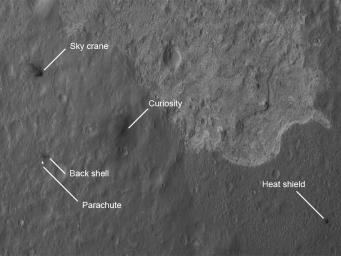
|
Scene of a Martian Landing
- Click the image above for a larger view
- Full-Res JPEG (946 x 710) (94.2 kB)
- Full-Res TIFF (946 x 710) (672.6 kB)
Caption:
The four main pieces of hardware that arrived on Mars with NASA's Curiosity rover were spotted by NASA's Mars Reconnaissance Orbiter (MRO). The High-Resolution Imaging Science Experiment (HiRISE) camera captured this image about 24 hours after landing. The large, reduced-scale image points out the strewn hardware: the heat shield was the first piece to hit the ground, followed by the back shell attached to the parachute, then the rover itself touched down, and finally, after cables were cut, the sky crane flew away to the northwest and crashed. Relatively dark areas in all four spots are from disturbances of the bright dust on Mars, revealing the darker material below the surface dust.
Around the rover, this disturbance was from the sky crane thrusters, and forms a bilaterally symmetrical pattern. The darkened radial jets from the sky crane are downrange from the point of oblique impact, much like the oblique impacts of asteroids. In fact, they make an arrow pointing to Curiosity.
This image was acquired from a special 41-degree roll of MRO, larger than the normal 30-degree limit. It rolled towards the west and towards the sun, which increases visible scattering by atmospheric dust as well as the amount of atmosphere the orbiter has to look through, thereby reducing the contrast of surface features. Future images will show the hardware in greater detail. Our view is tilted about 45 degrees from the surface (more than the 41-degree roll due to planetary curvature), like a view out of an airplane window. Tilt the images 90 degrees clockwise to see the surface better from this perspective. The views are primarily of the shadowed side of the rover and other objects.
The Curiosity rover is approximately 4,900 feet (1,500 meters) away from the heat shield; about 2,020 feet (615 meters) away from the parachute and back shell; and approximately 2,100 feet (650 meters) away from the discoloration consistent with the impact of the sky crane.
The image scale is 39 centimeters (15.3 inches) per pixel.
Background Info:
Complete HiRISE image products are available at: http://uahirise.org/releases/msl-descent.php .
HiRISE is one of six instruments on NASA's Mars Reconnaissance Orbiter. The University of Arizona, Tucson, operates the orbiter's HiRISE camera, which was built by Ball Aerospace & Technologies Corp., Boulder, Colo. NASA's Jet Propulsion Laboratory, a division of the California Institute of Technology in Pasadena, manages the Mars Reconnaissance Orbiter Project for NASA's Science Mission Directorate, Washington. Lockheed Martin Space Systems, Denver, built the spacecraft.
Cataloging Keywords:
| Name | Value | Additional Values |
|---|---|---|
| Target | Mars | |
| System | ||
| Target Type | Planet | |
| Mission | Mars Reconnaissance Orbiter (MRO) | Mars Science Laboratory (MSL) |
| Instrument Host | Mars Reconnaissance Orbiter | Curiosity Rover |
| Host Type | Orbiter | Rover |
| Instrument | High Resolution Imaging Science Experiment (HiRISE) | |
| Detector | ||
| Extra Keywords | Asteroid, Atmosphere, Dust, Grayscale, Impact, Shadow | |
| Acquisition Date | ||
| Release Date | 2012-08-07 | |
| Date in Caption | ||
| Image Credit | NASA/JPL-Caltech/Univ. of Arizona | |
| Source | photojournal.jpl.nasa.gov/catalog/PIA16001 | |
| Identifier | PIA16001 | |
